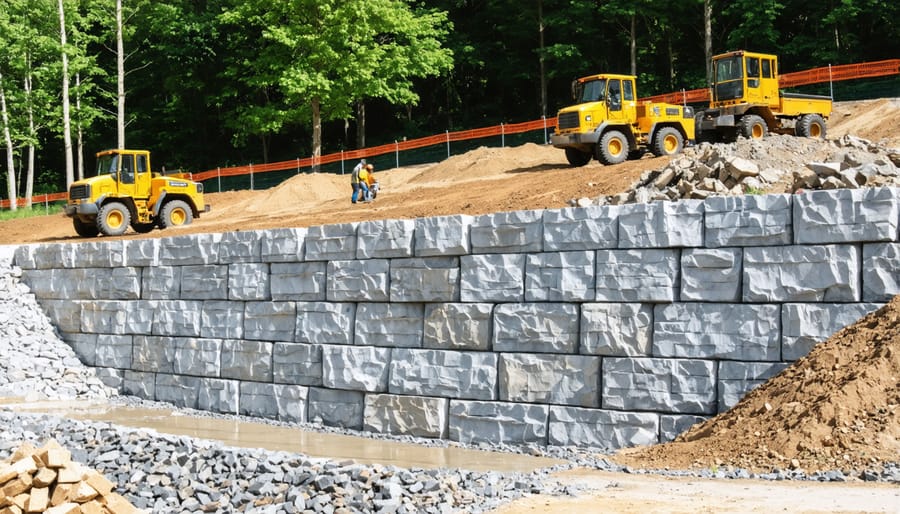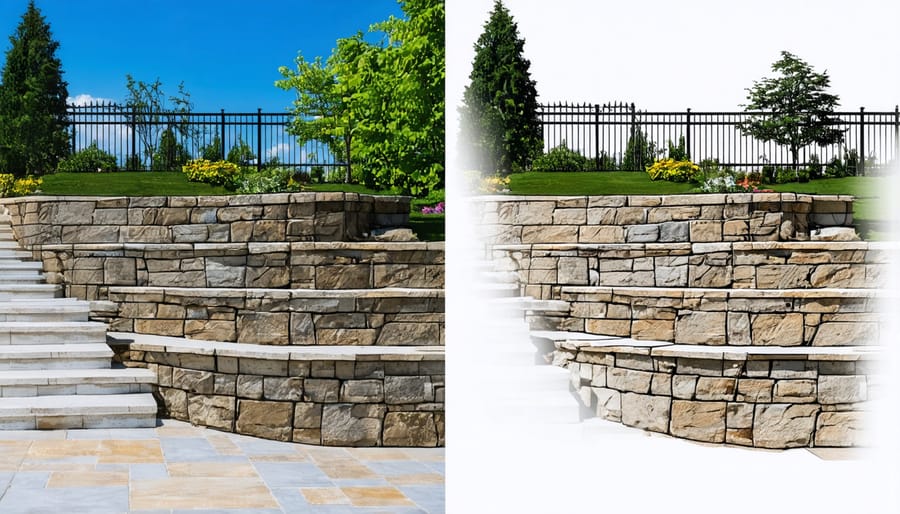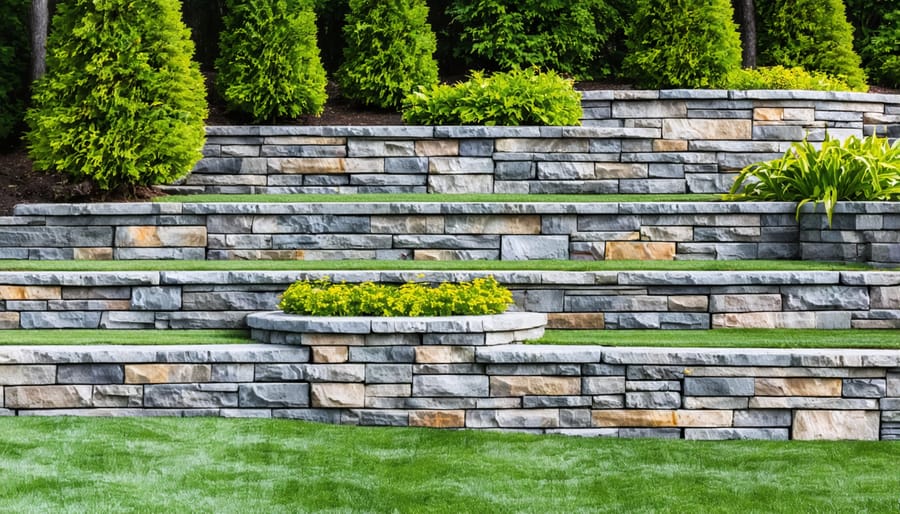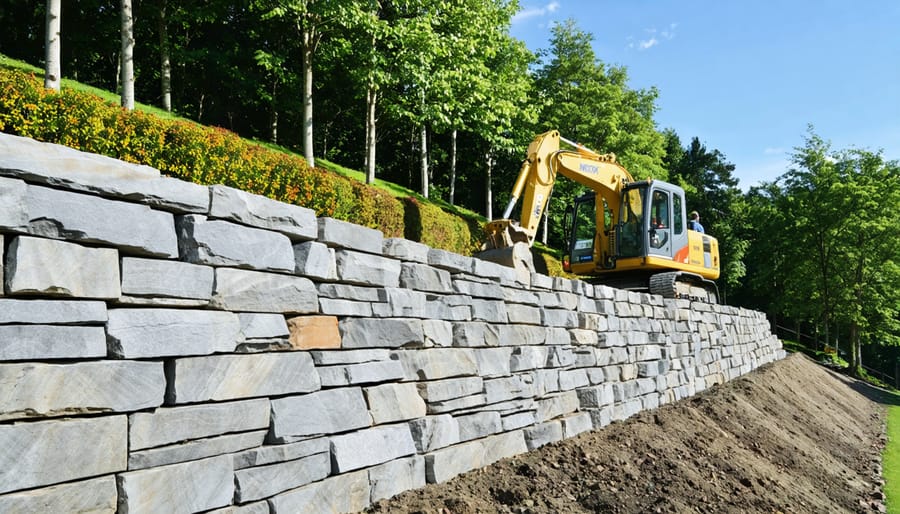Large natural stone retaining walls stand as timeless monuments of engineering and aesthetic brilliance, transforming challenging landscapes into valuable architectural assets. These robust structures, crafted from carefully selected natural stone blocks, not only prevent soil erosion and manage elevation changes but also create striking visual focal points that significantly enhance property value.
Beyond their functional role in land management, large stone retaining walls represent a premium investment that appreciates over time. Unlike manufactured materials, natural stone develops character with age, requiring minimal maintenance while delivering unmatched durability that can span generations. Property owners increasingly recognize these walls as sophisticated solutions that blend structural integrity with environmental sustainability.
Modern construction techniques have revolutionized how we approach these massive structures, enabling walls that seamlessly integrate with the natural environment while providing superior strength and stability. Whether supporting a hillside estate, creating dramatic terraced gardens, or establishing property boundaries, natural stone retaining walls offer an optimal balance of functionality, aesthetics, and long-term value that few other landscaping investments can match.
This comprehensive analysis explores the investment potential, design considerations, and lasting benefits of large natural stone retaining walls, helping property owners make informed decisions about this significant landscape enhancement.
The Initial Investment: Understanding the Costs
Material Costs and Quality Considerations
The choice of stone material significantly impacts both the initial investment and long-term performance of your retaining wall. While current retaining wall costs vary by region, premium materials like granite typically range from $25-40 per square foot, while limestone and sandstone fall between $15-30 per square foot. These higher-grade stones offer superior durability and aesthetic appeal, potentially lasting centuries with proper maintenance.
Quality considerations should focus on stone density, compression strength, and weather resistance. Granite excels in all these aspects, making it ideal for large retaining walls despite its higher cost. Limestone offers excellent workability and a classic appearance but may require more maintenance in harsh climates. Sandstone provides attractive color variations but needs careful selection for structural applications.
When evaluating materials, consider the wall’s exposure to elements, soil conditions, and local climate. Premium stones typically offer better freeze-thaw resistance and structural integrity, potentially reducing long-term maintenance costs and ensuring better value over the wall’s lifetime.
Installation and Labor Expenses
Professional installation of large natural stone retaining walls typically requires experienced contractors and specialized equipment. Labor costs generally range from $20 to $40 per square foot, depending on project complexity, site accessibility, and regional labor rates. This expense includes site preparation, foundation work, drainage system installation, and proper stone placement.
Installation involves heavy machinery such as excavators, skid steers, and cranes to safely move and position large stones. A typical crew consists of 3-5 skilled workers, with projects taking anywhere from several days to multiple weeks to complete. Additional costs may include engineering consultations ($500-$2,000), permits ($200-$1,000), and site preparation ($1,000-$5,000).
The installation process requires precise planning and execution. Contractors must account for proper base preparation, backfill materials, drainage systems, and geotextile fabric installation. While DIY installation might seem tempting, the complexity and safety requirements of large stone retaining walls make professional installation essential for ensuring structural integrity and longevity. Professional installation also typically includes warranties and guarantees, providing additional value and peace of mind.

Long-Term Value Appreciation
Property Value Enhancement
A well-constructed natural stone retaining wall represents one of the most profitable stone investments for property enhancement. Real estate professionals consistently report that homes with professionally installed natural stone retaining walls command higher market values, with increases typically ranging from 6% to 12% above comparable properties.
The value appreciation stems from multiple factors. First, natural stone retaining walls create usable space on sloped properties, effectively expanding the functional square footage of outdoor areas. This additional space can be utilized for gardens, patios, or recreational areas, making the property more attractive to potential buyers.
The timeless appeal of natural stone also contributes significantly to curb appeal, creating a sophisticated and established look that synthetic materials simply cannot match. Unlike manufactured alternatives, natural stone walls develop character over time, often becoming more aesthetically pleasing as they age.
Furthermore, properly constructed stone retaining walls can last for generations with minimal maintenance, providing long-term value that appreciates over time. Insurance companies often view these structures favorably, potentially leading to reduced premiums due to their role in preventing soil erosion and protecting property foundations.
When considering resale value, properties featuring natural stone retaining walls typically sell faster and command stronger negotiating positions, particularly in luxury real estate markets where authentic materials are highly valued.

Durability and Longevity Benefits
Natural stone retaining walls stand as monuments to durability, often outlasting their human creators by centuries. Unlike manufactured materials that typically deteriorate within decades, properly constructed natural stone walls can endure for 100-150 years or more with minimal maintenance. This exceptional longevity stems from stone’s inherent resistance to weathering, UV radiation, and extreme temperature fluctuations.
When compared to concrete blocks or timber alternatives, natural stone demonstrates superior structural integrity over time. While concrete may crack due to freeze-thaw cycles and timber eventually succumbs to rot and insect damage, natural stone actually strengthens as it ages. The stone’s mineral composition allows it to develop a protective patina that enhances its weather resistance.
The investment value of natural stone becomes particularly apparent when considering lifetime costs. Although initial installation expenses may be higher, the minimal maintenance requirements and extraordinary lifespan result in significantly lower long-term costs. Natural stone walls rarely need replacement or major repairs, unlike manufactured alternatives that typically require renovation every 20-30 years.
Moreover, natural stone’s timeless aesthetic actually improves with age, developing character and historical value that manufactured materials cannot replicate. This aging process, known as weathering, enhances the wall’s visual appeal while maintaining its structural integrity, making it an increasingly valuable asset to any property over time.
Maintenance and ROI Considerations
Minimal Maintenance Requirements
Large natural stone retaining walls are renowned for their minimal maintenance requirements, making them a cost-effective long-term investment. Unlike manufactured materials, natural stone’s durability means maintenance costs typically remain low throughout its lifetime, often requiring only periodic visual inspections and basic upkeep.
Annual maintenance primarily involves checking for water drainage efficiency and ensuring the weep holes remain clear of debris. This simple task can usually be performed by property owners themselves, involving only basic tools and minimal time investment. Every 3-5 years, professional inspection is recommended to assess structural integrity and address any potential issues before they develop into larger problems.
The most common maintenance tasks include removing any invasive vegetation growth between stones, cleaning accumulated soil from drainage areas, and occasionally pressure washing to maintain aesthetic appeal. In regions with freeze-thaw cycles, spring inspections are particularly important to identify any winter-related displacement or damage.
With proper initial construction and regular basic maintenance, natural stone retaining walls can last for generations without requiring significant repairs or renovation. This longevity, combined with minimal ongoing costs, contributes significantly to their appeal as a sustainable landscaping solution.
Cost Comparison with Alternative Materials
When comparing costs with alternative materials, natural stone retaining walls typically have higher initial costs than concrete blocks or timber options. While concrete blocks might cost $15-25 per square foot installed, and timber around $20-30, natural stone installations generally range from $25-45 per square foot. However, the long-term return on natural stone investment often justifies the higher upfront expense.
Engineered walls typically need replacement every 20-30 years, while natural stone walls can last a century or more with proper installation. This longevity significantly reduces the lifetime cost per year. Additionally, concrete blocks and timber require more frequent maintenance and repairs, increasing their total ownership costs.
Consider a 100-foot wall: While the initial investment might be $5,000 more for natural stone compared to concrete blocks, the elimination of replacement costs and reduced maintenance needs over 50 years could result in savings exceeding $15,000. Natural stone walls also maintain their aesthetic appeal longer, potentially increasing property value and reducing landscaping costs associated with masking aging concrete or deteriorating timber installations.
Environmental and Aesthetic Benefits
Sustainable Investment Choice
Natural stone retaining walls represent a sustainable choice that aligns with modern environmental consciousness. Unlike manufactured materials, natural stone requires minimal processing and has a significantly lower carbon footprint during production. These walls are sourced from local quarries, reducing transportation emissions and supporting regional economies.
The longevity of natural stone walls contributes substantially to their environmental benefits. With proper installation, these structures can last for generations without requiring replacement, reducing waste and the need for new materials. The stone’s thermal mass properties also help regulate surrounding soil temperatures, creating favorable conditions for plant life and soil biodiversity.
Natural stone walls provide excellent habitat opportunities for beneficial insects, small wildlife, and native plant species. The crevices and joints between stones create micro-ecosystems that support local biodiversity. Additionally, these walls can be dismantled and repurposed if needed, making them a truly sustainable building material.
The stone’s natural weathering process actually enhances its appearance over time, eliminating the need for artificial treatments or chemical sealants. This aging process occurs without releasing harmful substances into the environment, making natural stone retaining walls an environmentally responsible choice for property owners committed to sustainable landscaping practices.
Aesthetic Value and Curb Appeal
Large natural stone retaining walls serve as striking architectural features that dramatically enhance a property’s visual appeal. The natural variations in color, texture, and pattern create a timeless aesthetic that seamlessly integrates with the landscape, offering a sophisticated alternative to manufactured materials. These walls create a strong first impression, establishing a sense of permanence and luxury that contributes significantly to curb appeal.
The dimensional character of natural stone creates engaging shadow lines throughout the day, while the material’s natural weathering process adds character over time rather than degrading its appearance. When properly designed, these walls can transform challenging topography into architecturally interesting features, creating dynamic outdoor spaces that enhance the overall property value.
Property owners often find that natural stone retaining walls become focal points in their landscape design, serving as backdrops for gardens or creating striking terraced effects. Real estate professionals consistently note that well-executed stone retaining walls contribute positively to property marketability, as they represent both functional infrastructure and high-end landscaping. The enduring beauty of natural stone, combined with its structural permanence, makes these walls particularly attractive to potential buyers who appreciate quality construction and authentic materials.

Real Estate Market Impact
Large natural stone retaining walls significantly enhance property value and marketability, making them a worthwhile investment for homeowners and developers alike. According to recent real estate studies, well-designed stone retaining walls can increase property values by 5-15%, depending on the location and overall landscape integration. While the initial investment may seem substantial (as detailed in our essential retaining wall pricing guide), the long-term benefits often outweigh the costs.
Properties featuring natural stone retaining walls typically attract more attention from potential buyers, particularly in upscale neighborhoods or areas with challenging topography. These structures add a sense of permanence and luxury that manufactured materials simply cannot match. Real estate agents frequently highlight these features in listings, emphasizing their dual role as functional solutions and aesthetic enhancements.
The impact on marketability is especially pronounced in regions where terrain management is crucial. Homes with professional-grade stone retaining walls often sell faster than comparable properties without such improvements, as buyers recognize the value of pre-existing, well-constructed landscape solutions. Additionally, natural stone retaining walls contribute to improved outdoor living spaces, which has become increasingly important in modern real estate markets.
Insurance companies and mortgage lenders also view properly constructed stone retaining walls favorably, as they demonstrate proactive terrain management and reduce potential liability issues. This can translate into more favorable insurance rates and improved property assessment values, further enhancing the overall investment return.
Investing in a large natural stone retaining wall represents a significant but worthwhile commitment to your property’s value and aesthetic appeal. These structures offer an unmatched combination of durability, natural beauty, and functionality that can last for generations with proper maintenance. While the initial investment may be higher compared to alternative materials, natural stone retaining walls typically deliver superior returns through increased property values, reduced maintenance costs over time, and enhanced landscape stability.
The timeless appeal of natural stone, coupled with its ability to weather gracefully and integrate seamlessly with the surrounding environment, makes it an excellent choice for both residential and commercial properties. Beyond the aesthetic benefits, these walls provide crucial structural support and erosion control while creating valuable usable space on sloped terrain. When properly designed and constructed, a natural stone retaining wall can serve as a distinguished architectural feature that adds character and value to your property for 50 years or more.
For those considering this investment, the long-term benefits of choosing natural stone – including its sustainability, minimal maintenance requirements, and enduring beauty – make it a compelling choice that consistently proves its worth over time.










